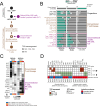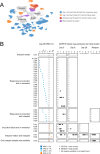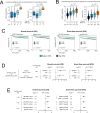A non-canonical lymphoblast in refractory childhood T-cell leukaemia
- PMID: 41224801
- PMCID: PMC12612194
- DOI: 10.1038/s41467-025-65049-8
A non-canonical lymphoblast in refractory childhood T-cell leukaemia
Abstract
Refractory cancers may arise either through the acquisition of resistance mechanisms or represent distinct disease states. The origin of childhood T-cell acute lymphoblastic leukaemia (T-ALL) that does not respond to initial treatment, i.e. refractory disease, is unknown. Refractory T-ALL carries a poor prognosis and cannot be predicted at diagnosis. Here, we perform single cell mRNA sequencing of T-ALL from 58 children (84 samples) who did, or did not respond to initial treatment. We identify a transcriptionally distinctive blast population, exhibiting features of innate-like lymphocytes, as the major source of refractory disease. Evidence of such blasts at diagnosis heralds refractory disease across independent datasets and is associated with survival in a large, contemporary trial cohort. Our findings portray refractory T-ALL as a distinct disease with the potential for immediate clinical utility.
© 2025. The Author(s).
Conflict of interest statement
Competing interests: D.T.T. receives research funding from BEAM Therapeutics and Neoimmune Tech. D.T.T. serves on advisory boards (unpaid) for Amgen, BEAM Therapeutics, Novartis, Jazz, J&J Innovation, Pfizer, Sobi, Servier and Syndax. D.T.T. holds patents or has patents pending: “Biomarkers predictive of cytokine release syndrome” (US11747346) and “Compositions and methods comprising anti-CD38 chimeric antigen receptors” (US20250121004, pending). C.G.M. receives research funding from AbbVie and Pfizer. C.G.M. has a consulting role with Amgen and Illumina. C.G.M. receives royalties from Cyrus. The remaining authors declare no competing interests.
Figures






References
-
- Hunger, S. P. & Mullighan, C. G. Acute lymphoblastic leukemia in children. N. Engl. J. Med.373, 1541–1552 (2015). - PubMed
-
- Malard, F. & Mohty, M. Acute lymphoblastic leukaemia. Lancet395, 1146–1162 (2020). - PubMed
-
- Goldberg, J. M. et al. Childhood T-cell acute lymphoblastic leukemia: the Dana-Farber Cancer Institute Acute Lymphoblastic Leukemia Consortium experience. JCO21, 3616–3622 (2003). - PubMed
-
- Conter, V. et al. Early T-cell precursor acute lymphoblastic leukaemia in children treated in AIEOP centres with AIEOP-BFM protocols: a retrospective analysis. Lancet Haematol.3, e80–e86 (2016). - PubMed
MeSH terms
Grants and funding
LinkOut - more resources
Full Text Sources
Research Materials

